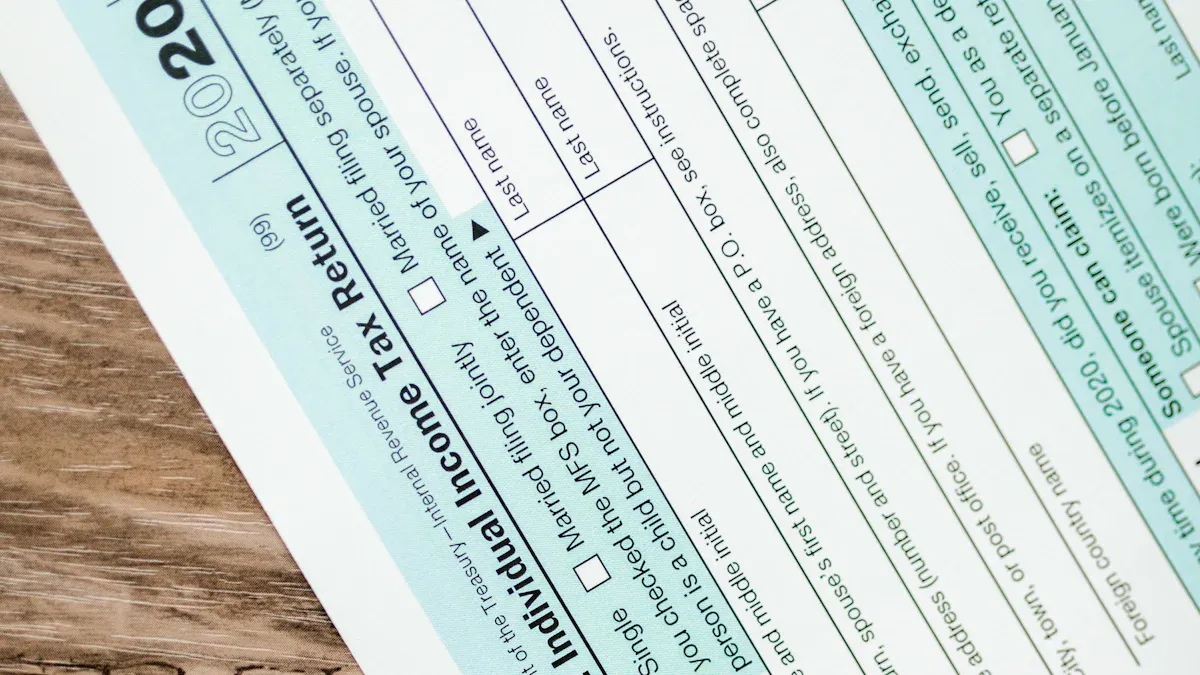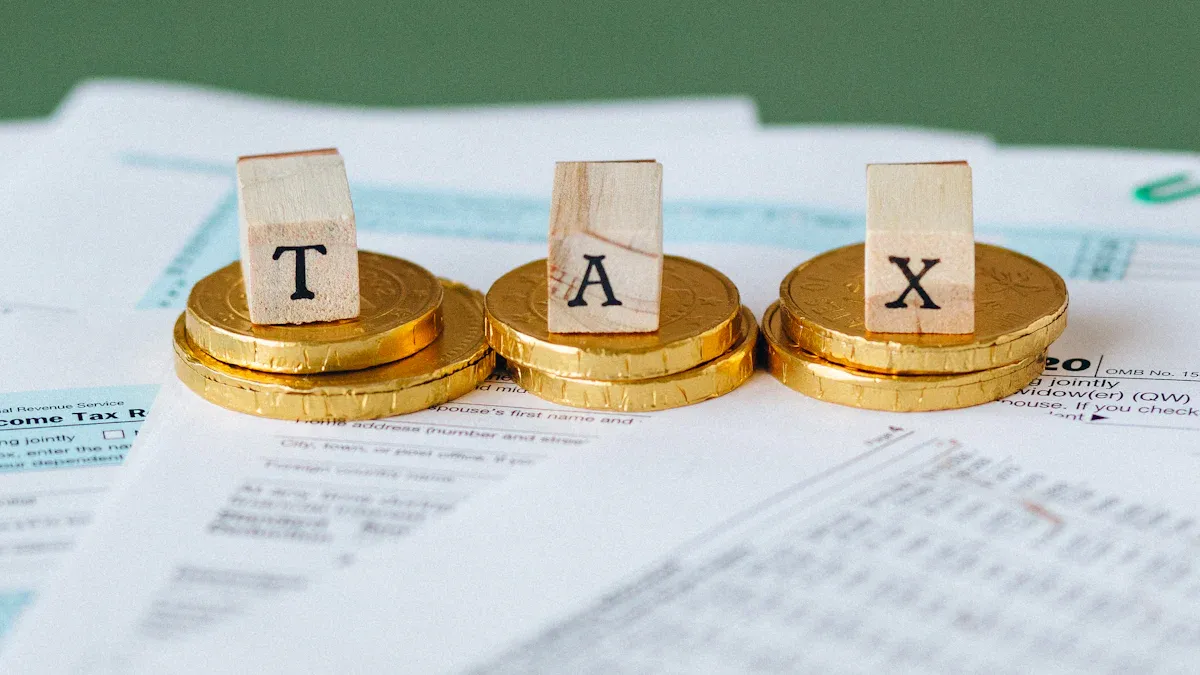- EasyCard
- Trade
- Help
- Announcement
- Academy
- SWIFT Code
- Iban Number
- Referral
- Customer Service
- Blog
- Creator
Common Tax Issues and Solutions for Chinese Investors Trading U.S. Stocks

Image Source: pexels
When trading U.S. stocks, you often encounter tax challenges such as high dividend tax rates, capital gains tax misconceptions, and low estate tax thresholds. Many investors face issues due to improper filing of the W-8BEN form, resulting in the inability to enjoy the tax benefits under the U.S.-China tax treaty and even facing scrutiny from the U.S. Internal Revenue Service (IRS). The table below outlines two main tax types and their rates in U.S. stock trading:
| Tax Type | Tax Rate | Description |
|---|---|---|
| Capital Gains Tax | 20% | Non-residents are generally exempt, but must meet identity and residency duration requirements. |
| Dividend Tax | 20% | The U.S. withholds 10%, and China requires an additional 10%, resulting in a high overall tax burden. |
You need to dynamically manage your tax status and plan your cash flow to better achieve compliance and tax-saving goals.
Key Points
- Fill out and regularly update the W-8BEN form to enjoy the 10% dividend withholding tax rate under the U.S.-China tax treaty, avoiding the high 30% tax rate.
- As a Chinese tax resident, you must declare all income from U.S. stock trading, including dividends and capital gains, and complete annual declarations on time to avoid penalties and additional taxes.
- Utilize the U.S.-China tax treaty to apply for tax credits to avoid double taxation by the U.S. and China, and plan your investment returns and tax status reasonably.
- Pay attention to CRS information exchange, ensure accurate declaration of overseas investment income, and mitigate tax risks and legal liabilities.
- Reasonably use investment losses to offset profits in the same year, and work with professional tax advisors to develop compliant tax plans to reduce overall tax burdens and risks.
U.S. Stock Trading Tax Types

Image Source: pexels
Dividend Tax
When you receive dividends from listed companies in U.S. stock trading, you need to focus on dividend tax. The U.S. imposes a 10% withholding tax on non-U.S. tax residents (including Chinese investors). U.S. brokers automatically deduct this tax when distributing dividends. Under the U.S.-China tax treaty, you also need to pay an additional 10% personal income tax in China. As a result, the total tax burden on dividends is approximately 20%.
| Applicable To | Dividends received during the holding period |
|---|---|
| Tax Rate Composition | U.S. withholds 10%, China requires an additional 10%, totaling about 20% |
Tip: Even if you incur an overall investment loss in a year, you still need to pay dividend tax if you receive dividends.
You should note that brokers automatically withhold the U.S. portion of the tax. You also need to actively declare and pay the remaining tax in China. The choice of broker registration location does not affect your tax obligations; the key lies in your tax residency status.
Capital Gains Tax
The profit you earn from buying and selling stocks in U.S. stock trading is considered capital gains. The U.S. generally does not impose capital gains tax on non-U.S. tax residents, provided you do not have a permanent establishment in the U.S. or engage in local business activities. This means most Chinese investors are exempt from U.S. capital gains tax.
However, as a Chinese tax resident, you must pay tax on your global income. Capital gains from U.S. stocks are classified as “property transfer income” and are subject to a 20% personal income tax rate. You can deduct eligible overseas investment losses before tax. If you have already paid related taxes in the U.S. or other regions, you can apply for a tax credit to avoid double taxation.
- When investing in Hong Kong stocks through channels like Stock Connect, capital gains are temporarily exempt from personal income tax, but this policy does not apply to U.S. stock trading.
- When investing in U.S. stocks through QDII funds, capital gains are temporarily exempt from tax, with dividends subject to withholding tax at the fund level.
- If you have paid taxes overseas, you can apply for a tax credit in China based on the tax treaty.
You need to declare capital gains from U.S. stock trading on your own and plan your investments reasonably to avoid underreporting and legal risks.
Estate Tax
The stock assets you accumulate through U.S. stock trading may be subject to U.S. estate tax in the future. According to the 2025 U.S. federal estate tax policy, the exemption amount is $13,990,000 (equivalent to the current RMB exchange rate). Only the portion of the estate exceeding this amount is subject to estate tax. While most investors will not reach this threshold, high-net-worth investors need to plan ahead.
Note: The U.S. estate tax threshold is high, but the tax burden is heavy once exceeded. You should monitor changes in your asset size and consult professionals to arrange cross-border wealth inheritance.
During U.S. stock trading, you must pay attention to your tax status, declaration process, and compliance risks. China has strengthened oversight of individual overseas income, clearly requiring income from U.S. stock trading to be subject to personal income tax. You need to actively declare to avoid tax risks due to increased information transparency.
Declaration Process
W-8BEN Form
When opening a U.S. stock trading account, you typically need to fill out the W-8BEN form. This form, issued by the U.S. IRS, is used by non-U.S. tax residents to declare their status and apply for tax treaty benefits. Properly filling out the W-8BEN form allows you to enjoy the dividend tax rate benefit under the U.S.-China tax treaty, reducing the U.S. dividend withholding tax rate from 30% to 10%. If you fail to submit or fill out the form incorrectly, brokers will default to withholding 30% tax, increasing your tax burden.
When filling out the W-8BEN form, you need to pay attention to the following key points:
- Accurately fill in your name, nationality (e.g., CHINA for China), home address (cannot use a P.O. box), mailing address (if different from home address), U.S. tax number (leave blank or write N/A if none), other countries’ tax numbers (leave blank or write N/A if none), account number (if required), date of birth, and place of residence (e.g., CHINA for China).
- The form is valid for three years and must be resubmitted upon expiration.
- You may sometimes need to provide proof of Chinese tax residency to verify your tax status.
- Failure to fill out or submit the form correctly may lead to tax issues and additional liabilities.
Tip: You can only enjoy the automatic 10% dividend tax withholding by U.S. brokers if you correctly submit the W-8BEN form. Otherwise, your tax burden will significantly increase.
U.S. Declaration
In U.S. stock trading, you generally do not need to file a capital gains tax return with the U.S. IRS as long as you do not have a permanent establishment in the U.S. or engage in local business activities. The U.S. exempts non-U.S. tax residents from capital gains tax. However, for dividend income, U.S. brokers will automatically withhold 10% tax based on your submitted W-8BEN form and remit it to the IRS. You receive the net amount after tax withholding and do not need to file or pay additional taxes in the U.S.
If you wish to reclaim over-withheld dividend tax, you can follow this process:
- Apply for an Individual Taxpayer Identification Number (ITIN) by filling out Form W-7 and submitting identity documents such as a passport.
- Fill out Form 1040-NR to request a refund for over-withheld dividend tax.
- Submit Form W-7, Form 1040-NR, identity documents, and a copy of Form 1042-S provided by the broker to the IRS.
- After obtaining an ITIN, wait for the IRS to issue a refund check.
- Some brokers automatically refund over-withheld taxes to your account between March and April each year.
When opening an account, you need to prepare a scanned copy of your Chinese passport or ID, ITIN approval notice, W-8BEN form, Chinese address and phone number, and Chinese bank account information. Note that the ITIN is valid for three years, and it’s recommended to file a zero-income return every three years to keep the ITIN active.
Note: You must comply with regulatory requirements and avoid using fake identities or proxy account-opening services, which could lead to account freezes or reporting to the IRS.
Common Misconceptions
During the U.S. stock trading declaration process, you may encounter the following misconceptions:
- Not understanding the U.S.-China tax treaty, leading to the application of incorrect withholding tax rates. For example, the U.S. has no bilateral tax treaty with Hong Kong, resulting in a 30% dividend withholding tax rate, while the U.S.-China treaty reduces it to 10%.
- Ignoring changes in international tax rules and continuing to use traditional tax-saving methods, which increases tax risks and costs.
- Confusing overseas and Chinese tax risks, overlooking the impact of Chinese tax law on equity structures and overseas income tax credits, leading to double taxation or increased tax burdens.
- Assuming that overseas investment income not remitted to China is tax-exempt, ignoring China’s personal income tax law’s global taxation principle.
- Using overseas holding companies to allocate funds or shareholder loans without repayment to avoid taxes, which may lack commercial reasonableness and trigger anti-tax avoidance clauses, leading to additional taxes and penalties.
- Underestimating the application of CRS information exchange and China’s big data audit technology, underestimating the tax authorities’ oversight of overseas income.
- Failing to declare overseas investment income accurately and on time, facing tax compliance risks and stricter future enforcement measures.
Recommendation: You should regularly monitor changes in tax policies, actively comply with declarations, and avoid tax risks due to increased information transparency. Consult professional tax advisors for complex situations.
Chinese Declaration Requirements

Image Source: pexels
Overseas Income
As a Chinese tax resident, you must declare your global income, including dividends and capital gains from U.S. stock trading. According to the People’s Republic of China Personal Income Tax Law, you should classify profits from U.S. stock trading as “property transfer income,” subject to a 20% tax rate. You need to complete the declaration between March 1 and June 30 of the following year after earning the income.
You can follow this declaration process:
- Confirm your status as a Chinese tax resident (e.g., having a domicile in China or residing in China for 183 days or more in a year).
- Fill out the Personal Income Tax Annual Self-Declaration Form (Form B).
- If you have paid taxes in the U.S., you can apply for a tax credit using U.S. tax documents or Hong Kong bank payment receipts.
- You can only offset U.S. stock gains and losses within the same tax year, and losses cannot be carried over to future years.
- Investments through channels like Shanghai-Hong Kong Stock Connect or Shenzhen-Hong Kong Stock Connect may enjoy tax exemptions for certain capital gains, but this does not apply to U.S. stock trading.
Tip: Failure to declare on time may result in the tax authorities requiring additional tax payments and late fees, with some cases involving penalties of up to hundreds of thousands of U.S. dollars (USD). Please take it seriously.
CRS Impact
The Common Reporting Standard (CRS) has become a key tool for Chinese tax authorities to monitor overseas accounts and investment income. Accounts you open with Hong Kong banks or other overseas financial institutions will have their information automatically exchanged with Chinese tax authorities via CRS. The tax authorities use big data and international information-sharing technology to track your overseas investments and income.
- You must truthfully declare all U.S. stock trading income, including amounts not remitted to China.
- Concealing or underreporting overseas income may lead to additional taxes, late fees, or even criminal liability.
- The tax authorities have issued multiple announcements reminding taxpayers to actively comply with declarations to avoid risks from increased information transparency.
Compliance Recommendations
To declare U.S. stock trading income compliantly and reduce tax risks, you can follow these recommendations:
- Actively review your U.S. stock accounts and investment income, and promptly organize tax payment proofs from U.S. brokers, Hong Kong banks, and other overseas institutions.
- If in doubt, consult professional tax advisors to ensure accurate declaration content.
- Stay informed about tax policy changes and reasonably use tax credits and investment loss deductions to reduce tax burdens.
- Address historical underreporting promptly to avoid penalties for late declarations.
- Compliant declarations are key to protecting your asset safety and avoiding legal risks.
Recommendation: As global tax regulatory technology advances, you should continuously optimize your tax arrangements to ensure every U.S. stock transaction is declared compliantly and transparently.
Risks and Planning
Avoiding Double Taxation
When investing in U.S. stocks, your biggest concern is likely the same income being taxed by both China and the U.S. In fact, China and the U.S. signed the Agreement on the Avoidance of Double Taxation in 1984, effective in 1986. This agreement allocates taxing rights and reduces withholding tax rates on dividends and interest, helping you reduce the tax burden of cross-border investments. You can use the treaty’s credit mechanism to offset taxes paid in the U.S. against your Chinese tax obligations. This way, you only need to pay the difference to avoid double taxation. The treaty also includes dispute resolution and information exchange provisions to protect your legal rights.
Tip: When declaring, keep tax payment proofs from U.S. brokers, Hong Kong banks, and other institutions to facilitate tax credit applications.
Equity Incentives
If you receive equity incentives from a U.S.-listed company, tax treatment becomes more complex. When exercising options, you must pay personal income tax at a rate of 3%-45% as wage and salary income, with the tax base being the market price minus the exercise price. Dividends received during the holding period are subject to a 20% dividend tax, and profits from selling the shares are subject to a 20% property transfer income tax. The table below summarizes the main tax stages:
| Tax Stage | Tax Type | Tax Rate | Description |
|---|---|---|---|
| At Exercise | Wage and Salary Income | 3%-45% | Market price minus exercise price multiplied by the number of shares |
| Holding Period Dividends | Dividend Tax | 20% | Dividend income must be declared separately |
| Sale and Realization | Property Transfer Income Tax | 20% | Sale price minus market price at exercise multiplied by the number of shares |
You should pay attention to the applicability of tax incentives and plan the timing of exercise and realization to avoid excessive tax burdens.
Tax Planning
You can reduce the overall tax burden of U.S. stock trading through various methods:
- Actively self-audit and report to the tax authorities promptly, as cooperation with audits can waive late fees.
- Use compliant channels like Stock Connect or cross-border ETFs, where some products’ capital gains are temporarily tax-exempt.
- Before year-end, “sell losses to preserve gains” to offset profits with losses in the same year, reducing taxable income.
- Consult professional tax agencies for personalized planning solutions to avoid declaration errors.
- Maintain a long-term compliance approach and avoid using offshore accounts or third-party nominal transactions.
You should align your investment structure and cash flow with tax treaties and credit policies to ensure every U.S. stock transaction is declared compliantly and transparently, reducing future tax risks.
In U.S. stock trading, compliant declarations and risk prevention are critical. Please refer to the following checklist:
- Fill out the W-8BEN form promptly to enjoy the 10% dividend tax rate benefit.
- Actively declare all U.S. stock trading income, including dividends and capital gains.
- Properly retain Hong Kong bank statements, U.S. tax documents, and other materials for tax audits.
- Use the U.S.-China tax treaty to apply for tax credits to avoid double taxation.
- Comply with CRS information exchange regulations, stay informed about tax policy changes, and prevent penalties due to negligence.
Recommendation: Regularly review your investment accounts and declaration records, and consult professionals promptly for any doubts to ensure every cross-border investment is compliant and secure.
FAQ
Do you need to declare U.S. stock trading income in China?
You need to declare. Chinese tax law requires you to pay tax on your global income, including dividends and capital gains from U.S. stock trading. You should complete your annual declaration within the specified period.
What are the consequences of not filling out the W-8BEN form?
If you do not fill out the W-8BEN form, U.S. brokers will withhold 30% dividend tax. You will not enjoy the 10% preferential tax rate under the U.S.-China tax treaty, significantly increasing your tax burden.
How can you apply for a tax credit for taxes withheld in the U.S.?
You can apply for a tax credit in China using tax documents from U.S. brokers or Hong Kong banks. You only need to pay the tax difference to avoid double taxation.
Does CRS information exchange affect your U.S. stock account?
Yes, it does. Hong Kong banks and other financial institutions will automatically exchange your account information with Chinese tax authorities via CRS. You need to truthfully declare to avoid tax risks.
Can losses from U.S. stock investments offset other income?
You can only use U.S. stock investment losses to offset profits from U.S. stock trading in the same tax year. You cannot offset losses against wages, interest, or other income types, nor carry losses forward to future years.
This article provides a detailed analysis of common tax issues and solutions for Chinese investors in U.S. stock trading. It delves into key tax types such as dividend tax, capital gains tax, and estate tax, offering practical guidance on topics like filling out the W-8BEN form, leveraging the U.S.-China tax treaty, and meeting Chinese reporting requirements. The article emphasizes the importance of compliant reporting and provides a clear tax planning roadmap for investors.
However, despite the comprehensive nature of the article, a core challenge for many Chinese investors remains: the flow of cross-border funds. Traditional funding methods, such as international bank wire transfers, are not only complex and time-consuming but also come with high fees and opaque exchange rate spreads. These issues can directly impact investment returns and increase transaction costs.
BiyaPay was created to solve these cross-border financial pain points. We offer a smoother, more cost-effective channel for your investments. We support the conversion between various fiat and digital currencies, allowing you to easily manage global assets, and provide a real-time exchange rate query feature to ensure you always get the best rates. What’s more, our remittance fees are as low as 0.5% with same-day delivery, significantly cutting down your transaction costs and time. Now, you don’t need a complex overseas account to invest in both U.S. and Hong Kong stocks on one platform. Say goodbye to the hassle of cross-border payments and start your efficient financial journey. Register with BiyaPay today to make fund management as smooth as trading.
*This article is provided for general information purposes and does not constitute legal, tax or other professional advice from BiyaPay or its subsidiaries and its affiliates, and it is not intended as a substitute for obtaining advice from a financial advisor or any other professional.
We make no representations, warranties or warranties, express or implied, as to the accuracy, completeness or timeliness of the contents of this publication.




Contact Us
Company and Team
BiyaPay Products
Customer Services
is a broker-dealer registered with the U.S. Securities and Exchange Commission (SEC) (No.: 802-127417), member of the Financial Industry Regulatory Authority (FINRA) (CRD: 325027), member of the Securities Investor Protection Corporation (SIPC), and regulated by FINRA and SEC.
registered with the US Financial Crimes Enforcement Network (FinCEN), as a Money Services Business (MSB), registration number: 31000218637349, and regulated by FinCEN.
registered as Financial Service Provider (FSP number: FSP1007221) in New Zealand, and is a member of the Financial Dispute Resolution Scheme, a New Zealand independent dispute resolution service provider.



















